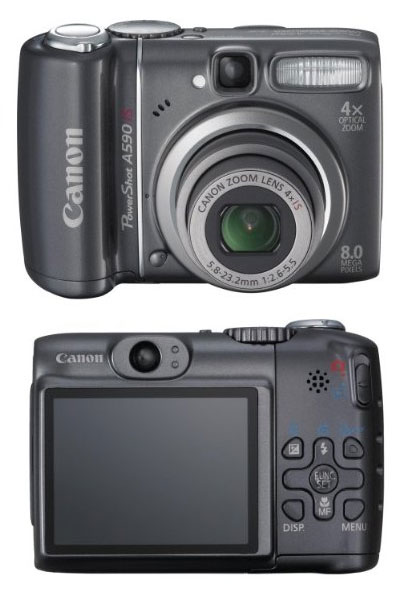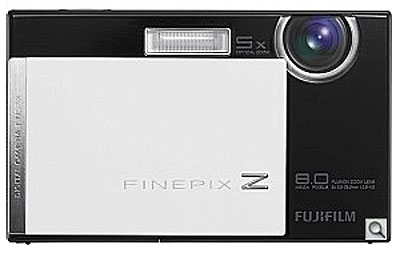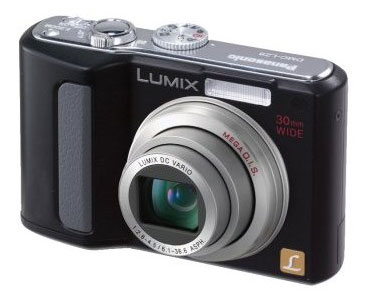Digital Cameras for the Holidays
by Wesley Fink on November 27, 2008 12:00 AM EST- Posted in
- Digital Camera
Entry Digitals
The entry Point-and-Shoot market is toughest of all to navigate. Every company seems to pile on more hype - most of which is meaningless - in an effort to persuade the unknowing into buying their camera. Before we make our recommendations, let's talk about a few things to avoid.
Digital zoom is totally meaningless and does nothing for your photos. It means either the camera chooses high ISO in low light or that the camera crops the picture it takes and digitally stretches the result to make it appear that it zoomed. Neither one does anything good for your pictures. The only zoom that matters is optical zoom, which is the zoom range of the fixed lens.
Image Stabilization - or IS, Mega OIS, VR, and other names - is important. Image Stabilization allows you to hand hold the shot in lower light than normally possible. This is very important with P&S since the tiny sensors always compromise ISO "film" speed and low light performance. Look for this feature as it makes a difference in the quality of the pictures you take.

For just over $100 you can buy the Canon Powershot A590 IS. The A590 lists for $149, and it's worth it, but a little shopping will find you an even better price. The A590 features IS (Image Stabilization), a very good quality 4x zoom lens (35-140mm equivalent), and a bright 2.5" LCD in an 8.0MP dark graphite body. It features the latest in face detection and motion detection technology and produces good quality images in full auto mode or the wide selection of scene modes that work well in tricky lighting.
Experienced users, or those who want to grow with their camera, will appreciate the range of control from all Auto to adjustable ISO, color, contrast, white adjustment, and sharpness/saturation. You also get Program, Aperture Priority, Shutter Priority, and full Manual , which is very rare in an entry level point-and-shoot. In addition to the 4x optical zoom there is an added 4x digital zoom that works better than most, but keep in mind that digital zoom is of much more limited use than true optical zoom.
The A590 is small but not tiny. In the end it delivers great images right out of the box in full auto mode - there's even an easy mode for complete beginners. When you want more, there is a very wide range of adjustments you can grow with. "Film" is SD or SDHC cards and power is two AA batteries - not bad for a camera that costs just over $100.

Some prefer a really tiny camera that fits easily in a purse, pocket, or backpack. A good choice for those who like thin and small is the Fuji Z100FD. This tiny camera actually packs a 5x (36-180mm) optical zoom and an 8.0MP sensor in that tiny body. It also delivers an excellent image for the cost of around $119 if you shop for it. It achieves super small size by using a small rechargeable Li-Ion battery and comes with the battery and charger. It does away with the optical finder to keep things small, but the LCD is a large 2.7". The Z100FD is also the first Z series to feature Image Stabilization and Automatic Red-Eye Removal.
The Z100FD is available in Shell Pink, Cappuccino Brown, and Tuxedo Black in addition to the standard Satin Silver. The colors will likely be a hit for those who want to tuck it in their purse, but you may have to pay more for colors other than Silver. When it was introduced, the Fujifilm Z100FD had a suggested price of $249, but it has dropped to $199 and can be found today at $115 to $120 at large etailers like Newegg and BuyDig.

Another excellent choice in the beginner P&S category is the Panasonic Lumix DMC-L8. This 8.1MP model features a 5x (32-160mm) optical zoom lens and an exceptionally wide ISO range of 100-6400. Other features are definitely competitive with the best in this category.
If you are wondering why all our choices are around 8MP, it is because of the tiny sensors used in point-and-shoot cameras. 8MP seems to be the sweet spot for current P&S sensors. You can still achieve a wider usable ISO range and keep noise reasonably low. When you go beyond 8MP with these small sensors, image quality deteriorates very fast. Our advice here is to avoid the 12 to 15MP point-and-shoots and stick to 7 to 9MP for best overall performance.










41 Comments
View All Comments
Flyboy27 - Friday, November 28, 2008 - link
Nikon D40. Seriously why would I need anything with more MP. Talk about fast and easy to use. Size and weight are very reasonable too. I can turn it on and take a picture before your p/s warms up.Flyboy27 - Friday, November 28, 2008 - link
I would like anandtech to have a serious discussion about magapixels. Why do higher megapixels matter? For web? no! The only way MPs matter is if your printing huge and by huge I mean greater than 20x30. How many times do you need prints that big anyways. Anyone that wants ultimate resolution is going to shoot film anyways. Film can be scanned by a professional lab at higher resolution than any DSLR can take. Just because you have a 20MP camera doesn't mean that you can resolve all those pixels anyways. My point? It is dumb to pay more for more megapixels. Any modern digital camera has enough MPs for any amateur and most pros.WTF is pro-sumer? = amateur photo geek with money. I doubt that pro photographers read this site for advice on cameras. They know what they want already.
All this said (if you want an upgrade from the D40) I think the D90 by Nikon would be a great camera if you want to go that route. It is not worth paying more for any other camera.
I bought a DSLR for the ability to learn to use an SLR camera without having to pay for film. I can learn from my mistakes instantly instead of waiting for film to be developed/scanned. If I already knew how to use an SLR and was comfortable I would be shooting 35mm film and getting it scanned at a much higher resolution than any digital camera.
Wesley Fink - Saturday, November 29, 2008 - link
If readers want to look a little deeper at sensor resolution, sensor size, and noise, take a look at our two part series on the Digital Sensor in The Digital Sensor: A Guide to Understanding Digital Cameras at http://www.anandtech.com/digitalcameras/showdoc.as...">http://www.anandtech.com/digitalcameras/showdoc.as... and The Digital Sensor: Part 2 at http://www.anandtech.com/digitalcameras/showdoc.as...">http://www.anandtech.com/digitalcameras/showdoc.as....Flyboy27 - Saturday, November 29, 2008 - link
Thanks Wesley,I wont go into Digital vs. Film. That is something that a person can only decide for himself. I've already gone into my reasons why I shoot digitally. Besides its all about getting great pictures right? It is my belief that you can get great pictures from most of the cameras out there. Some cameras just make it easier to take more great pictures.
Now my beef with resolution. Just as you have to sit close enough to a 1080p TV at a given size to tell the difference between it and a 720p set the same goes with digital photography. You have to ask yourself "What am I doing with these pictures that I'm going to be taking?" Am I going to make wall size prints? probably not. Am I going to make 20x30" prints? Maybe a few. Am I going to make 5x7s or 12x18s. Definitely. Am I going to use these photos on the web? Most Definitely. These are my answers and yours may be different but based on mine all I'll ever need is 6-10 mp. Fantastic, I don't have to pay extra for more mega pixels just because all the marketing says I do. Marketing tries it's hardest to make you go out an buy more than you need because they have to make money in order to make more cameras and stay in business.
I do take issue with Norman Koren's test. In the test he scanned the film with a $700 scanner. Big deal. He just wiped out any advantage that film might have. He's comparing a digital camera with a scanner, not film. Once again I'm not saying film or digital are better than one another. Pros use both.
I will check out Clark looks interesting and very technical.
I do love anandtech. Quality articles, objective testing. I've recently stopped reading another site due to the slow decline in the quality of their articles/publishing philosophy. Anandtech is now my main source for news and advice on computer hardware. Plus you actually respond intelligently to commentators and most of the commentators comment intelligently as well. Thanks guys.
Wesley Fink - Saturday, November 29, 2008 - link
Can you please provide the source for your information that film has higher resolution than any digital sensor? There are many experts who disagree with you.Norman Koren, the author of Imatest, which is a well-respected Resolution Test Suite, found the resolution of the top films to be equivalent to an 8.3 megapixel full-frame DSLR sensor at http://www.normankoren.com/Tutorials/MTF7.html">http://www.normankoren.com/Tutorials/MTF7.html. Clark at
http://www.clarkvision.com/imagedetail/film.vs.dig...">http://www.clarkvision.com/imagedetail/film.vs.dig... found that Fuji Velvia 100 and 50 were equivalent to a 10 megapixel sensor for intensity detail, and perhaps a 16 megapixel sensor for color detail. All other films he tested, including slide films, were lower in resolution. You can find charts for a wide variety of films at that link.
Clark's final conclusion was 10 to 16 megapixels were the equivalent range of the various film types. Since his work was mostly APS-C sensors it is not really at odds with Koran's tests.
Every other researcher who has tested has generally found 12 to 14 megapixels the equivalent of 35mm film. The larger resolution sensors do show any faults of your lenses and they require the very best glass to resolve those high resolutions.
We did discuss the relevance of megapixels in the article in the discussion of P&S cameras. Our recommendation was that cameras with these tiny sensors - 1/10 to 1/20 the size of an APS-C sensor - have reached the best balance of resolution and noise at around 7 to 9 megapixels. Anything more than this is a waste with these tiny sensors TODAY, but that could change with new sensor technology.
However, in the APS-C sensor the resolution trade-off probably is somewhere around 20 to 25 megapixels with current technology and somewhere around 40 to 50 megapixels in full-frame. Since the sensor is an Analog device that gathers light and converts it to digital info the physical size of the pixel is the most important specification for judging ISO range and noise.
Prosumer is a designation used by almost every camera review site. It is the same as Advanced Amateur. It basically means a class of cameras geared to the hobbyist or advanced amateur that is also used by some Pros. The lines have become particularly blurred as sealing has improved in this class and technical advances have accelerated in digital imaging.
computerfarmer - Friday, November 28, 2008 - link
Nikon D40 is a good camera with 6mp. Then there is the Nikon D40x with 10mp. Both have 23.7 x 15.6 mm CCD sensors. The D40x has ISO 100 and the D40 does not, it starts at ISO 200. The D60 has very little on the D40x and in some cases the D40x is better.You are correct in the fact the D40 will do the job and very well at that.
Nehemoth - Friday, November 28, 2008 - link
I would like to get one new camera bellow the 200US mark, but I don't like the cannon design and I would like that only use 2 AA batteries (so some fujifilm are out), also I like the aesthetics of those old cameras, like DSLR design.Any recomendation?.
computerfarmer - Friday, November 28, 2008 - link
The FujiFilm FinePix S700 has the DSLR look and is selling for 179CDN. It uses 4 AA batteries and has a 10x zoom. you can read user comments herehttp://www.dpreview.com/reviews/read_opinions.asp?...">http://www.dpreview.com/reviews/read_opinions.asp?...
Good luck
Nehemoth - Friday, November 28, 2008 - link
That's what I said before, I don't want fujitsu cause use 4 batteries, I would like of just 2 batteries.ubiloo - Friday, November 28, 2008 - link
I've been shooting since more than 20 years, I've used a lot of cameras from Canon, Nikon and Pentax.Even though the Pentax lacks a full-frame camera (shame! shame!), I'm deeply convinced of the fact that some current models really are among the best for the price. Why is Pentax so often absent from parades?
In particular, I think that the K200D is terrifying for its street price (I don't know about the K-m); I've now been using it for some time and it's a real solid camera with good, sometimes very good, picture quality. I bought it for at least €100 than any comparable camera. This particular model also deletes one of the drawbacks of previous models: with its kit lens, the auto-focus speed is really convincing, try to believe!
As for lenses, both Sigma and Tamron are available, so whenever Pentax is weak, they deliver...